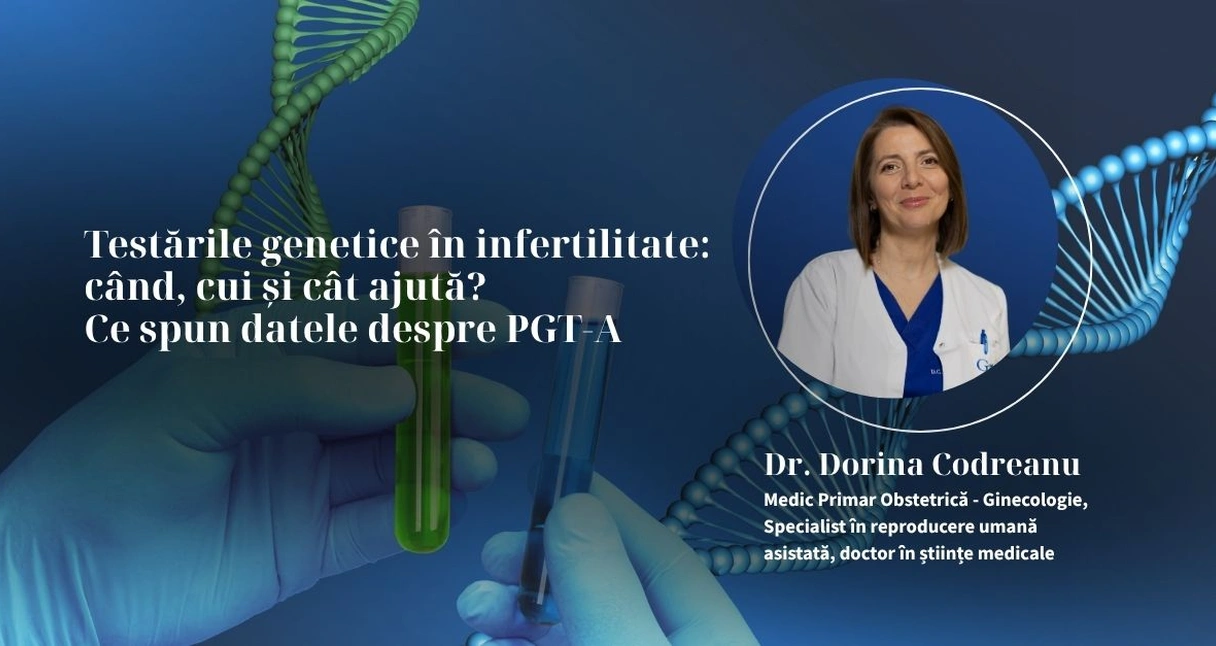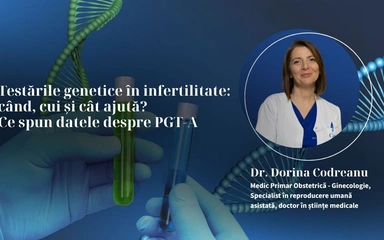Genetic Testing in Infertility: When, for Whom, and How Helpful Is It?
What the Evidence Says about PGT-A

Infertility often has genetic components – from chromosomal abnormalities associated with implantation failure or early miscarriage, to monogenic diseases that can be prevented through embryo selection. The integration of genetics into the IVF pathway follows two main objectives:
- increasing the chances of delivering a healthy baby, and
- shortening the time to pregnancy, with minimal risk.
Types of Genetic Tests Used in Infertility Evaluation:
- Couple Screening (Pre-IVF): Karyotyping, Y chromosome microdeletions, carrier screening (e.g. for cystic fibrosis), FRAXA/FMR1, thrombophilia testing in selected contexts.
Purpose: To identify the genetic causes of infertility and the potential risks of passing them on. - PGT-M / PGT-SR: Preimplantation testing for known monogenic diseases or balanced chromosomal rearrangements. Use: Highly targeted, used when there’s a known family mutation/genetic disease.
- PGT-A (Preimplantation Genetic Testing for Aneuploidy): Screening of all 24 chromosomes via NGS (Next Generation Sequencing) to select euploid embryos.
Purpose: To reduce miscarriages and/or failed transfers, and potentially shorten the time to live birth.
PGT-A: What Clinical Studies Say
Large RCTs up to 2021
- NEJM 2021 (Yan et al.): 1,212 patients with ≥3 high-quality blastocysts – no increase in cumulative live birth rate vs. morphological selection; slight decrease in clinical miscarriage rate. Conclusion: Limited benefit on CLBR in unselected population.
- STAR 2019 (Munné et al.): No overall advantage in all age groups; possible benefit for ages 35–40 with ≥2 biopsiable embryos (not significant in ITT analysis).
Meta-analyses & recent reviews (2023–2024)
- Kasaven 2023 (PMC): Slight benefit per transfer (RR ~1.09), but findings limited by heterogeneity and “per transfer” bias.
- Frontiers in Endocrinology 2023 (RPL): Benefit in implantation/live birth rates in patients with recurrent miscarriage.
2024–2025 updates
- Pilot RCT (King’s College London, 2025): 100 women aged 35–42 – CLBR of 72% vs. 52% in 3 transfers; time to pregnancy shorter with PGT-A. Small, open-label trial – needs confirmation.
- Observational data: Suggest improved outcomes in women ≥38 years; no clear benefit in younger women.
Position Statements (2022–2025):
- ASRM 2024: PGT-A can be helpful in selected contexts (advanced maternal age, RPL, multiple embryos), but is not universally recommended.
- ESHRE 2022: Detailed recommendations for mosaic embryos and need for prenatal follow-up.
- HFEA UK 2024–2025: PGT-A remains an “add-on” with limited evidence of benefit – advises individualized decision-making
Controversies and Safety Concerns
- False positives and potential exclusion of viable embryos (e.g., mosaics).
- Emphasis on transparency and informed consent.
- Legal cases reported (US, 2025) regarding misclassification of embryos.
Clinical Interpretation & Best Use of PGT-A
- PGT-M / PGT-SR: Clearly indicated for known genetic risks (monogenic disorders, translocations).
- PGT-A:
- May benefit women ≥38 years with multiple blastocysts by reducing failed transfers and shortening time to pregnancy.
- Not proven to improve CLBR in general IVF population.
- May reduce miscarriage rates in certain subgroups.
- Limitations: Cost, risk of excluding mosaic embryos, inter-lab variability.
Who Benefits Most from PGT-A?
- Women ≥38 years with several high-quality embryos.
- Couples with recurrent pregnancy loss (RPL).
Essentials of PGT-A Counseling:
- Clarify the real goal (shortening time to pregnancy vs. increased live birth rates).
- Number of embryos available for testing.
- Maternal age – the strongest predictive factor.
- Policy on mosaic embryos – thresholds, order of transfer, follow-up.
- Transparency about uncertainties and guidelines (ASRM, ESHRE, HFEA).
Conclusions:
- PGT-M / PGT-SR – Strongly recommended with clear genetic indications.
- PGT-A – Useful selection tool, not a guaranteed solution. Evidence shows possible benefit in older patients, but large multicenter trials are still needed. Personalized decision and thorough genetic counseling are essential.



